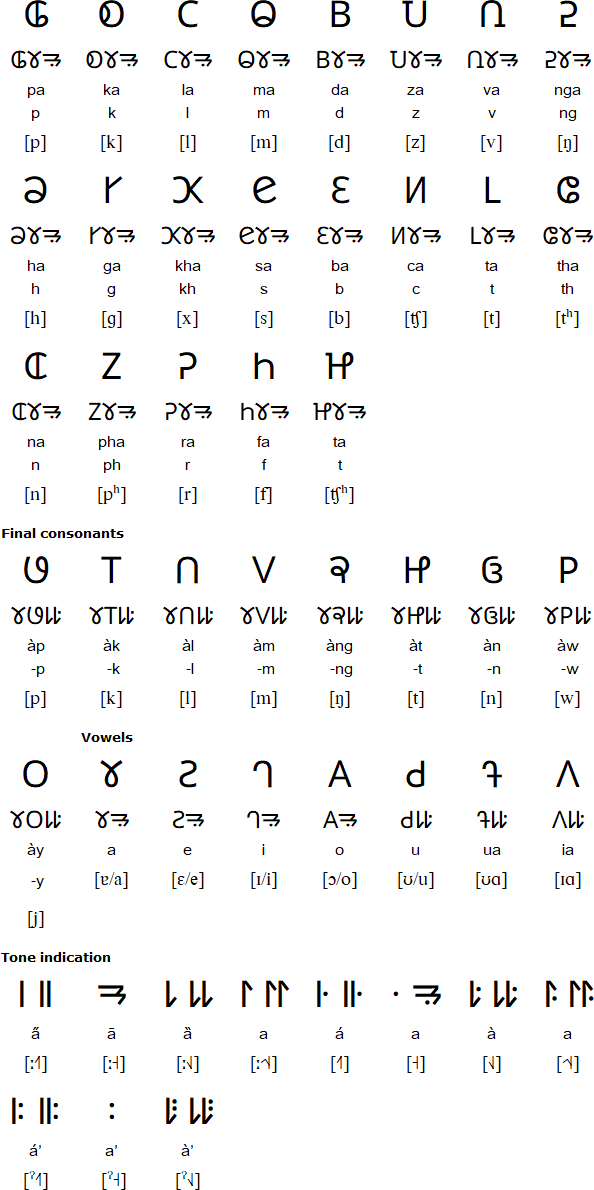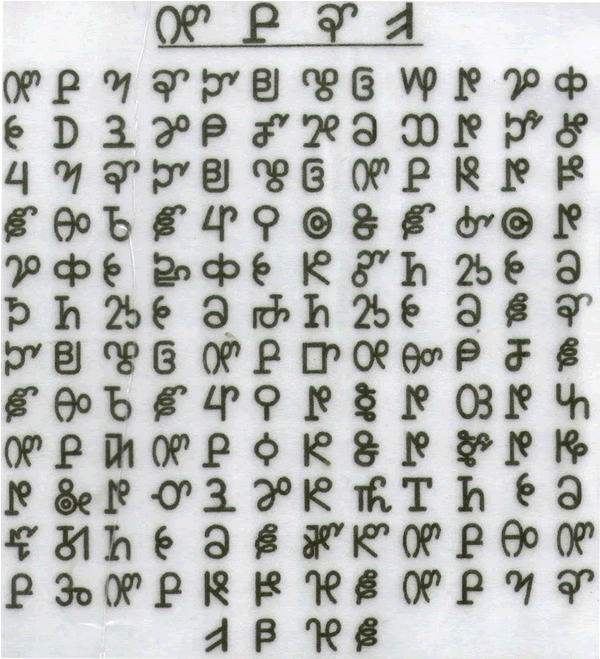
The Pau Cin Hau script was created in 1902 by Pau Cin Hau, a religious leader in Chin State in the northwest of Burma / Myanmar. The original script was logographic and consisted of 1,050 symbols, which was the number of characters in a religious text. He also developed a simplified alphabetic version of the script with 57 letters.
The letters used in the Pau Cin Hau script are similar to the letters of the Latin and Burmese scripts. The script is known as Paw-Cín-Hàw-Lày (Pau Chin Hau script) or Tual-Lày (local script).
The Pau Cin Hau script can be used to write Tedim, a Kukish language spoken in northwestern Burma / Myanmar, and other related languages. It has been used for some Christian literature in the early 20th century. After most speakers of Tedim and other Chin languages became Christians in the 1950s, people started using the Latin alphabet rather than Pau Cin Hau script.
The alphabetic version of Pau Cin Hau script was encoded in Unicode in 2014. The logographic script has yet to be encoded.

Download an alphabet chart for Pau Cin Hau (Excel)
Hear the pronunciation of the Pau Cin Hau letters:
Information about the Pau Cin Hau script provided by Wolfram Siegel

Information about Pau Cin Hau and his script
https://en.wikipedia.org/wiki/Pau_Cin_Hau
https://en.wikipedia.org/wiki/Pau_Cin_Hau_script
http://glyphs.webfoot.com/blog/2011/05/10/pau-cin-hau-logograms-1902-ad-mayanmar/
A-chik Tokbirim, Adinkra, ADLaM, Armenian, Avestan, Avoiuli, Bactrian, Bassa (Vah), Beitha Kukju, Beria (Zaghawa), Borama / Gadabuursi, Carian, Carpathian Basin Rovas, Chinuk pipa, Chisoi, Coorgi-Cox, Coptic, Cyrillic, Dalecarlian runes, Elbasan, Etruscan, Faliscan, Fox, Galik, Georgian (Asomtavruli), Georgian (Nuskhuri), Georgian (Mkhedruli), Glagolitic, Global Alphabet, Gothic, Greek, Hurûf-ı munfasıla, Irish (Uncial), Kaddare, Kayah Li, Khatt-i-Badí’, Khazarian Rovas, Koch, Korean, Latin, Lepontic, Luo Lakeside Script, Lycian, Lydian, Manchu, Mandaic, Mandombe, Marsiliana, Medefaidrin, Messapic, Mongolian, Mro, Mundari Bani, Nag Chiki, Naasioi Otomaung, N'Ko, North Picene, Novo Tupi, Nyiakeng Puachue Hmong, Odùduwà, Ogham, Old Church Slavonic, Oirat Clear Script, Ol Chiki (Ol Cemet' / Santali), Old Italic, Old Nubian, Old Permic, Ol Onal, Orkhon, Osage, Oscan, Osmanya (Somali), Pau Cin Hau, Phrygian, Pollard script, Runic, Székely-Hungarian Rovás (Hungarian Runes), South Picene, Sutton SignWriting, Sunuwar, Tai Viet, Tangsa, Todhri, Toto, Umbrian, (Old) Uyghur, Wancho, Yezidi, Zoulai
Page last modified: 15.03.23
[top]
You can support this site by Buying Me A Coffee, and if you like what you see on this page, you can use the buttons below to share it with people you know.

If you like this site and find it useful, you can support it by making a donation via PayPal or Patreon, or by contributing in other ways. Omniglot is how I make my living.
Note: all links on this site to Amazon.com, Amazon.co.uk
and Amazon.fr
are affiliate links. This means I earn a commission if you click on any of them and buy something. So by clicking on these links you can help to support this site.
[top]